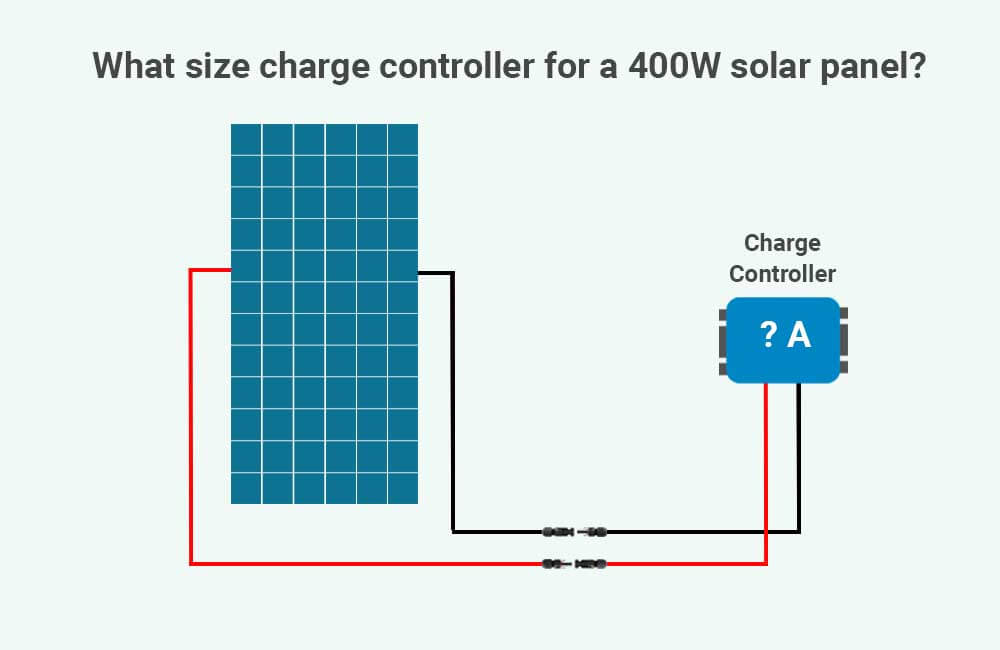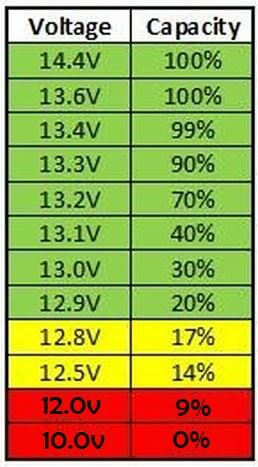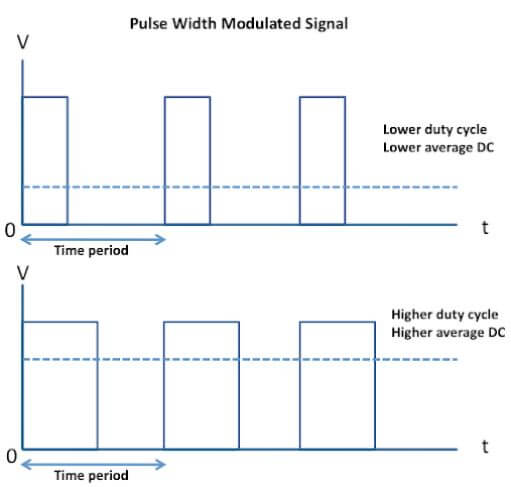The main rating of a solar charge controller is its Output Current rating (in Amps), and this rating represents the maximum amount of current that the charge controller will be able to deliver at its output.
However, when sizing a charge controller for your 400W solar panel you’ll also have to pay attention to another rating: the Maximum Input Voltage rating of the charge controller (in Volts).
Both of these ratings can be determined by using the specifications of your solar panel(s) and battery bank.
In this article, I’ll discuss which of the specifications of your solar panel(s) and battery are relevant, and how to use these specifications to determine the right charge controller for your 400W system.

What size charge controller for 400W solar panel?
Generally, 400W solar panels are rated at 24 Volts (nominal); if both the solar panel and the battery are rated at 24V, the charge controller should be rated at 20 Amps if it’s an MPPT or 15 Amps if it’s a PWM.
If your 400W solar panel is rated at 24V, and your battery bank is only rated at 12V, you should use an MPPT charge controller, and it should be rated at 40 Amps. If you use a PWM charge controller, more than 50% of your solar panel’s power production would go to waste.
If your 400W solar panel is rated at 12V, or it’s a 400W solar array that consists of 12 Volt solar panels wired in parallel, and your battery bank is also rated at 12 Volts, the charge controller should be rated at 40 Amps if it’s an MPPT, or 30 Amps if it’s a PWM.
As a general rule, an MPPT charge controller would always allow your solar panel to produce more power. Still, if your solar panel and battery bank have the same nominal voltage, you could use either an MPPT or a PWM. Otherwise, it is recommended to use an MPPT charge controller.
Another important thing to note is that, in any case, the Max. Input Voltage rating of the solar charge controller should be greater than the maximum amount of voltage that your solar panel is capable of producing.
With systems of this size, most solar charge controllers have a Max. Input Voltage rating of at least 50 Volts, which is sufficient if your 400W solar panel (or array) is rated at 12V. However, if the solar panel (or array) is rated at 24V, the charge controller should be rated for more than 60 Volts at its input.
Our MPPT calculator will easily determine the required Output Current(A) and Input Voltage (V) ratings of the charge controller that you need and will provide a couple of options. All you have to do is submit some specifications that describe your system.
However, if you’re more interested in manual calculations, the next section will explain this thoroughly.
How to select the right charge controller for your 400W solar panel
As explained above, there are 2 main ratings you have to consider when choosing a solar charge controller:
- The Output Current rating (in Amps).
- The Maximum Input Voltage rating (in Volts).
Let’s begin with the first rating.
How to determine the Output Current rating of the charge controller?
The process of determining the Output Current rating of the charge controller that you need will depend on whether it’s an MPPT or PWM charge controller. This is because these 2 types of charge controllers operate differently and also need to be sized differently.
You can learn more about the difference between these 2 types in our article about the function of solar charge controllers.
Let’s first see how to calculate the Output Current rating required from an MPPT.
How to determine the required Output Current rating of an MPPT?
Power is the product of Voltage and Current: Power (Watts) = Voltage (Volts) x Current (Amps).
For example, for this 395W solar panel from HANWHA to produce 395 Watts of power, it would have to produce 10.71 Amps of current and 36.88 Volts across its terminals:
Power (Watts) = Voltage (Volts) x Current (Amps)
Power (Watts) = 36.88 Volts x 10.71 Amps
Power (Watts) = 395 Watts
In order to protect the battery, an MPPT charge controller would have to lower the voltage from the solar panel to match that of the battery. But, it does this while preserving the same amount of power.
So, the MPPT doesn’t just lower the voltage, it transforms the power coming from the solar panel from a high voltage/low current kind of power, to a relatively lower voltage/higher current kind of power. While the voltage is decreased, the current is increased by the same ratio, and the amount of power doesn’t change.
For example, let’s say the same 395W solar panel is used to charge a 12V battery bank.
The voltage of our 12V battery bank will vary depending on its State Of Charge (SOC).
When the battery bank is depleted (0% SOC), the voltage across its terminals becomes about 10 Volts.

And this is the voltage at which the MPPT will produce the most amount of current at its output.
Let me explain.
In order to be able to charge the battery bank, the voltage at the output of the MPPT will always need to be slightly higher than that of the battery bank. So, when the battery bank is empty, and its voltage is about 10 Volts, the MPPT charge controller will produce around 10.5 Volts at its output.
Since the amount of power from our solar panel doesn’t change, the amount of current that the MPPT needs to be able to produce at its output can be calculated as such:
The output Current rating of the MPPT (Amps) needs to be at least The Power Rating of the solar panel (Watts) ÷ Lowest Charging Voltage (Volts)
The output Current rating of the MPPT (Amps) needs to be at least 395 Watts ÷ 10.5 Volts
The output Current rating of the MPPT (Amps) needs to be at least 37.6 Amps
A 40 Amp MPPT charge controller would be a good fit for this setup.
If our battery bank was rated at 24V, the lowest charging voltage would be 21 Volts. Using the same formula (395 ÷ 21 ) the MPPT would have to be rated at 20 Amps.
Now, let’s see how to calculate the Output Current rating required from a PWM.
How to determine the required Output Current rating of a PWM?
PWM charge controllers also lower the voltage from the solar panel to protect the battery, but instead of transforming and maintaining the power production, they just disconnect and reconnect the solar panel in a way that lowers the average voltage that the battery bank sees.

This does protect the battery, but since there’s only a decrease in voltage, and no increase in current, a portion of the power produced by the solar panel is lost. The greater the difference between the voltages of the solar panel and the battery bank, the less efficient a PWM charge controller is going to be.
Now, when trying to determine the output current rating required in a PWM, the power rating of the solar panel is somewhat irrelevant. What is relevant, is the maximum amount of current expected from the solar panel.
The PWM charge controller has to be sized in a way that it can handle the maximum amount of current expected from the solar panel.
So, how do we determine this maximum current?
Well, according to the NEC (the American National Electrical Code), Article 690.8 (A) (1), the Maximum Current is:
Maximum Current (Amps) = Short-Circuit Current (Amps) x 1.25
The Short-Circuit Current (Isc) rating of a solar panel is usually specified on the spec label stuck to its back.
If your 400W solar array consists of multiple solar panels in parallel, simply sum up the short-circuit current ratings of the solar panels to determine the total short-circuit current. If it consists of multiple identical solar panels in series, the short-circuit current is equal to that of one solar panel.
Read more about the current of solar panels series vs parallel here.
For example, let’s say our 400W solar panel is rated at 24V (nominal) and has a short-circuit current rating of 11 Amps:
The output Current rating of the PWM (Amps) needs to be at least Short-Circuit Current (Amps) x 1.25
The output Current rating of the PWM (Amps) needs to be at least 11 Amps x 1.25
The output Current rating of the PWM (Amps) needs to be at least 13.75 Amps
A 15 Amp PWM would be a good fit.
However, as explained above, it would only make sense to use a PWM if the solar panel (or array) and the battery bank have the same nominal voltages (both 24V or both 12V). If the nominal voltage of the solar panel is higher than that of the battery bank, use an MPPT instead.
Now that we’ve seen how the Output Current rating of these charge controllers is determined, let’s discuss the 2nd rating that should be considered.
How to determine the Maximum Intput Voltage rating of the charge controller?
Solar charge controllers have a voltage interval in which they can operate. If the voltage is too low, the charge controller will not work at all, but if the voltage is too high, the charge controller could be damaged.
Chances are your 400W solar panel will provide enough voltage for the charge controller to operate, but you’ll need to make sure the charge controller is designed to withstand the maximum amount of voltage expected from the solar panel.
To do this, you’ll need to consider 2 things:
- The Open-Circuit Voltage of the solar panel (or array).
- The lowest temperature the solar panel (or array) is going to be exposed to in sunlight hours.
The Open-Circuit Voltage (or Voc) of a solar panel represents the voltage that the solar panel produces when the circuit is open (hence the name), and it is the highest amount of voltage that the solar panel is capable of producing under standard test Conditions (STC).
Just like the other specifications, you can determine the Voc of your solar panel by referring to the spec label or data sheet provided by the manufacturer.
If your 400W solar panel consists of multiple solar panels in series, simply add up the Open-Circuit voltages together to determine the total Voc. If it consists of multiple identical solar panels in parallel, the total Voc is equal to that of a single solar panel.
Learn more about the voltages of solar panels in series vs parallel here.
Following our example of the 395W solar panel from Hanwha, the manufacturer specifies a Voc of 45.27V. However, as mentioned above, 45.27 Volts would be the highest amount of voltage this solar panel produces, but in Standard Test Conditions (STC).
In Standard Test Conditions, the temperature is 77°F (about 25°C), and although it might sound counter-intuitive, if the temperature goes below 77°F (about 25°C) while the solar panel is under sunlight, the Voc of our solar panel will exceed 45.27 Volts.
In other words, under sunlight, when your solar panel is producing voltage, if the ambient temperature goes below 77°F (about 25°C), the actual Open-Circuit Voltage of the solar panel will exceed the rated Voc value.
You can estimate this potential increase in Open-Circuit Voltage by using the following formula:
Corrected Open-Circuit Voltage (V) = Open-Circuit Voltage (@ STC) x Correction Factor
The Temperature Correction Factor to be used will depend on the temperature, and is provided in NEC Table 690.7 (A):
| Ambient Temperature (°F) | Correction Factor | Ambient Temperature (°C) |
| 68 to 76 | 1.02 | 20 to 24 |
| 59 to 67 | 1.04 | 15 to 19 |
| 50 to 58 | 1.06 | 10 to 14 |
| 41 to 49 | 1.08 | 5 to 9 |
| 32 to 40 | 1.10 | 0 to 4 |
| 23 to 31 | 1.12 | -5 to -1 |
| 14 to 22 | 1.14 | -10 to -6 |
| 5 to 13 | 1.16 | -15 to -11 |
| -4 to 4 | 1.18 | -20 to -16 |
| -13 to -5 | 1.20 | -25 to -21 |
| -22 to -14 | 1.21 | -30 to -26 |
| -31 to -23 | 1.23 | -35 to -31 |
| -40 to -32 | 1.25 | -40 to -36 |
For example, let’s say our particular 400W solar panel will be in an area where, in the month of December, the sun goes down at about 5:30 PM. And let’s also assume that historically, in that same area in December, around 5-5:30 PM, the temperature can potentially go as low as 25°F (about -4°C).
If we look at the table above, we can see that for temperatures between 23°F (-5°C) and 31°F (-1°C), a correction factor of 1.12 must be applied to the Voc.
In our example, the rated Voc at standard conditions is 45.27 Volts. Let’s multiply that by 1.12 to determine our maximum voltage:
Corrected Open-Circuit Voltage (V) = Open-Circuit Voltage (@ STC) x Correction Factor
Corrected Open-Circuit Voltage (V) = 45.27 Volts x 1.12
Corrected Open-Circuit Voltage (V) = 50.7 Volts
According to our estimates, the solar charge controller that we need for our 400W solar panel must have a Max. Input Voltage rating of more than 50.7 Volts.
Again, by providing a few specs that describe your system, our MPPT calculator can perform all of these calculations for you and find a couple of suitable choices.
Related Topics:
What size wire from the solar panel to the charge controller?
What size fuse between the solar panel and the charge controller?


Great information, thank you! However, maybe you can help us figure this out: We are trying to run a skylink – off grid. We are setting up a separate battery bank (two 12v batteries in parallel) to power the sky link…
We have gotten by on a small system to power only our computers and phones for years, 4 batteries, 4, 100w solar panels. (we are no experts but we try to do everything ourselves, no experts where we are).
I have found a 440w solar panel at a great price… PROBLEM. I can’t find a 12v MPPT controller rated at higher than 260watts!!
I can find a 24v MPPT controller rated at 540w max. Can a 24v MPPT controller be used??
I have determined that we need 1kilowatt a day to run our system; that requires at least 350watt solar panels. (we need 100w + 35w for the “extender”) per my uneducated attempt and figuring this…I found a calculator that says we need 1k. per day.
We have rigged 2 -12v batteries in parallel. (we tried just 1, and we have a non MPPT, cheap controller) The duration has improved, but we are not there yet! We both used our computers/phone yesterday for maybe half the day, which meant for say 5 hours we were consuming 100w, and for 5 hours 45watts. At 10pm, we ran low on power, there was over 12v in the system but it wouldn’t power the transformer enough to run the skylink.
So, back to the main question!
can I use a 24v MPPT controller on this 12v system to handle a 440watt solar panel? I suppose I could cover part of it… still, I can’t even find a 12v that goes over 260watt max. input!
thank you!
Hey Christy, thank you for taking the time to write this up.
Have you tried our MPPT calculator. It will send you links directly to the MPPT you need. For example, you could use one of these 2:
– Epever
– Victron
I hope this helps.